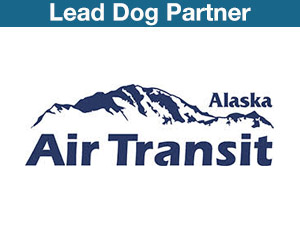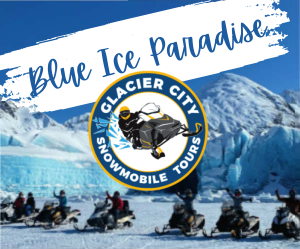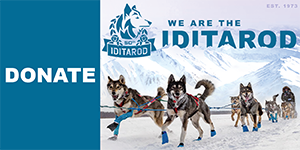by Donald Bowers, Jr.
Quick Overview
This leg follows the ancient Kaltag portage, a relatively straight valley angling southwest through the coastal mountains; the route has been used for millennia by Natives. It is normally a well-used snowmachine highway. It marks the major transition from the inland river environment to the Bering Sea coast. Conditions can be vastly different at opposite ends of the portage, and wind is a constant threat on the western half.
The distance to Unalakleet is actually about 82 miles. Plan on 10 to 15 hours for this trip, depending on whether you want to camp along the way, and for how long. (By this stage of the race your team may be able to make it without a major rest.) If the weather gets bad, though, this trip can easily take 18 or 20 hours. There are two excellent resting spots on the trail, fifteen miles apart: the Tripod Flats cabin is 35 miles from Kaltag, and the Old Woman cabin is 15 miles farther on, about 35 miles from Unalakleet. Both are snug log cabins maintained by BLM and the local villages and can provide welcome refuges in case you encounter a storm.
The trail climbs for 15 miles from Kaltag through mostly wooded country to the summit of the portage, about 800 feet above sea level. Then it descends slowly into the valley of the Unalakleet River, staying mostly in wooded or semi-wooded country with some excursions across taiga and open areas until Old Woman, then running across mostly open tundra on the south side of the river valley. The trail drops back down onto the Unalakleet River about 8 miles out of town, making a couple of short portages across river bends before crossing the frozen lagoon into Unalakleet.
Check the weather carefully before leaving Kaltag. In a few years the race has actually been shut down because of storms on the coast, or drivers were at least advised not to leave Kaltag. Watch conditions closely as you work your way to the sea, and be prepared to hole up in one of the shelter cabins if conditions turn bad, which they can do out here with breathtaking swiftness.
On this stretch of trail the primary markings will be permanent four-inch metal reflectors on trees, or on wooden tripods in open areas. Most of the reflectors are yellow or gold, but many have weathered to various shades of off-white; they still reflect well, but may be hard to spot during daylight. You might want to keep your headlight on in twilight periods to help you pick out the reflectors.
The permanent reflectors often mark a corridor rather than a specific track; this corridor can be a hundred yards wide, and there are multiple markers in many sections. The exact hard-packed trail will usually be marked with standard Iditarod trail stakes. This can be a major factor on the western end of the trail where it runs for miles across open tundra and the wind can drift everything in within minutes. When the trail is drifted over, you’ll want to try to follow the trail stakes because that’s where the packed trail is. (You don’t want to be floundering through unpacked open snow with your dog team if you can avoid it.)
Detailed Description
You’ll leave Kaltag toward the airport (which lies a mile west of town) and then run along the right (north) side of the runway for a mile. The trail then works southwest up the valley of the Kaltag River through woods and occasional open areas, slowly climbing. After about ten miles the trail begins to climb more steeply in places, eventually angling up the south side of the valley to the summit of the portage, 800 feet above sea level and 15 miles from Kaltag. There may be some narrow stretches with some sidehill in the last few miles to the summit, along with a few moderate grades, but normally nothing too serious.
Once past the summit you’ll drift southwestward along the north side of the valley, slowly descending. The trail will pass through a mix of wooded areas, taiga, and open stretches, occasionally dropping down to cross small streams (all of which should be well frozen). About 15 miles past the summit you’ll enter an area of pothole lakes and the trail will go over what appear to be sand dunes. Shortly after, you’ll come out onto a long, gently sloping flat area; this is Tripod Flats.
Toward the far end of Tripod Flats will be a standard wooden BLM sign pointing to the Tripod Flats cabin, a hundred yards off the trail in the trees on the left. The access trail makes a loop for easy-off, easy-on. The cabin has a good stove and bunks and is open to all comers. If you stop there, just be sure to replenish the firewood before you pull out. (This is basic Bush etiquette—the next person to use the cabin may need fire RIGHT NOW!)
Immediately after the Tripod Flats sign, the trail will cross a bridge over a rather deep ditch. There are no railings on the bridge, so try to stay in the middle. After a few more miles of gentle hills you’ll notice the Unalakleet River flowing in from the right (north). It will swing southwest and will become the chief river in the portage valley you’re following.
The trail will stay on the south side of the river, running across low hills and ridges and dipping down to cross some side creeks and rivers. At one point the trail will run along a bluff close above the Unalakleet River. In this area you’ll begin to see Old Woman Mountain, with its distinctive flat top. The trail will head directly toward the mountain, eventually running for a mile or so along some looping sloughs of the Old Woman River. The trail will swing off the sloughs and into the trees, where you’ll see an old plywood cabin. This is the original Old Woman cabin, 15 miles past Tripod Flats and 32 miles from Unalalkeet. It’s still usable and has a good stove, although it’s a bit the worse for wear and has been mildly trashed over the past few years. If you stop here, make sure you leave something (such as food) for the Old Woman when you leave. You don’t want her ghost chasing you to Nome and throwing bad luck your way.
After the old cabin, the trail winds back along the Old Woman River a bit farther and then heads out of the river bottoms to the west. As soon as you come out of the treeline and onto the tundra you’ll see a BLM sign for the new Old Woman cabin, just off the right of the main trail. It also has an easy off, easy on access trail. This snug log cabin is similar to the Tripod Flats cabin, and even has an outhouse. By the way, none of the cabins on this trail has water readily available; you’ll have to melt snow for your cooker if you want to feed the dogs a proper meal.
As soon as you leave the new Old Woman cabin, the trail will run on the open tundra, staying a mile or two south of the greenbelt along the Unalakleet River cut through some straggly treelines along creeks flowing in from the south, but mostly you’re out in the open. This stretch of trail (all the way to Unalakleet) is notorious for wind and drifts and sudden snowstorms. There are also some patches of light overflow and glaciering. Watch carefully for the markings; in the open areas, the markings are fastened on wooden tripods every few hundred yards.
At night you should be able to pick out the flash of the Unalakleet airport beacon (green, then white), or at least its reflection. As long as you can see the beacon flash, you’ll know it’s not snowing between you and Unalakleet. In this respect you’ll be like the early airmail pilots, flying at night in all kinds of weather from one airway beacon to the next.
You’ll cross one relatively large stream flowing in from the south, the Chiroskey River. It has a significant treeline and you’ll cut through a mile-wide wooded stretch in the process of crossing it. The Chiroskey is about 16 miles from Unalakleet.
After the Chiroskey you have eight more miles on the tundra before the river makes a 45-degree right turn and drops back down onto the Unalakleet River for the final run into town. To repeat: this stretch of trail is treacherous in bad visibility or when the wind is blowing and there’s any snow to move around. Be VERY careful to go from trail marker to trail marker if conditions get bad.
One you’re back on the river you have 8 miles to go, but you’re not home free yet, although you’re much better off than out on the open tundra. The weather can still be bad enough to keep you from finding your way to town. The trail makes a couple of portages to stay to the north side of some bends. There are plenty of trees along the river if you need shelter, as well as a number of cabins.
You’ll finally cut up a low hill and at the top you’ll see Unalakleet sitting on its barren spit across a frozen lagoon. The snow is usually very sparse for the last few miles into town, and the last mile across the lagoon is often on glare ice. If the wind is blowing (the town’s name means Place Where the East Wind Blows) it can be an interesting skate.
The checkpoint is usually in the old semi-abandoned Covenant School gymnasium, which is opened up for the race every year. The checker and his assistants will meet you and guide your team to the parking area around the old school.
There is a kitchen in the gym to serve mushers and the relatively large contingent of race personnel here. Unalakleet is a major logistics hub for the race and the Iditarod Air Force bases out of here for its work along the coast. In previous years the sleeping room has been upstairs behind the gym; take your sleeping bag in with you after yoursquo;ve got the dogs taken care of. You can hang your wet gear in the boiler room to dry. There is usually hot water available for dog food and even showers if you want one.
Unalakleet has a couple of well-stocked stores and a restaurant. It’s the biggest town between Wasilla and Nome, with about 800 people. You’re about 275 miles from Nome and this a good place to plan your strategy for the next few days. For the most part, the country from here to Nome is like nothing yoursquo;ve ever seen before—meaning generally bleak and windy, and that’s on the good days—and you need to be prepared for anything.

































